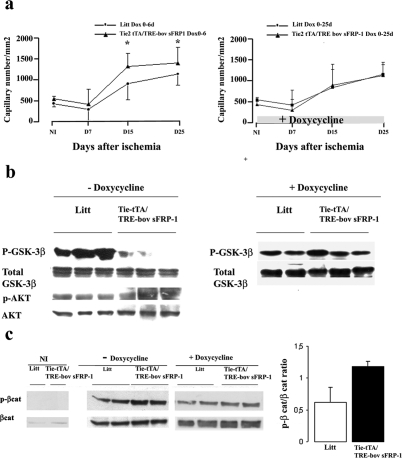Figure 8.
Role of sFRP-1 in neovessel formation and on the level of phosphorylated GSK-3β and β-catenin after hindlimb ischemia. a: Quantitative evaluation of capillary density using CD31 immunostaining (number of vessels/mm2) in tissues retrieved from ischemic anterior tibialis muscle of littermates and Tie2-tTA/TRE-bov sFRP-1 mice treated from day 0 to day 6 with doxycycline (Dox, 0 to 6 days) after ischemia. *P < 0.001 and in mice treated with doxycycline after ischemia, from day 0 to day 25 (Dox, 0 to 25 days) after ischemia with doxycycline. *P < 0.001. Treatment through the whole period of ischemia with doxycycline in Tie2-tTA/TRE-bov sFRP-1 animals, switched off bovine sFRP-1 expression and restored a kinetics of capillary density similar to that in littermates, thereby confirming the specific role of endothelial bovine sFRP-1 in the modulation of the angiogenic response after ischemia. The levels of either p-GSK-3β and GSK-3β total (b) or p-β-catenin and total β-catenin (c) was compared by Western blot in Tie2-tTA/TRE-bov sFRP-1 versus littermate (Litt) in hindlimb extracts at day 15 after ischemia. Doxycycline was removed from the drinking water 6 days after ischemia, allowing sFRP-1 induction (−doxycycline). Controls were done with mice treated from day 0 to day 15 after injury with doxycycline (+doxycycline). A quantification of the ratio of phospho-β-catenin:β-catenin is presented.

